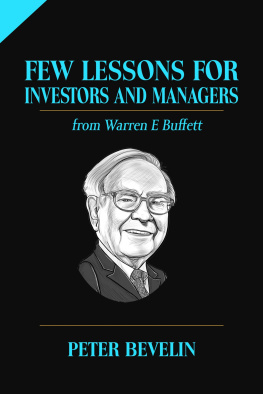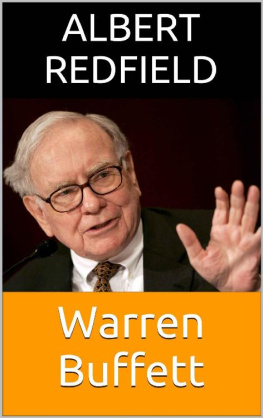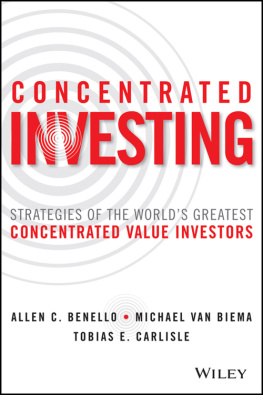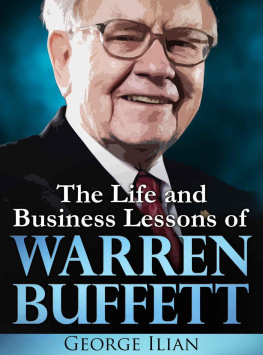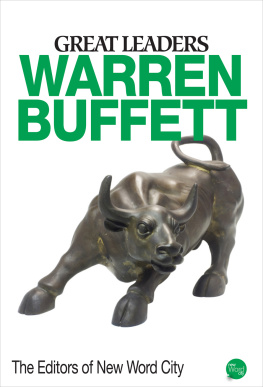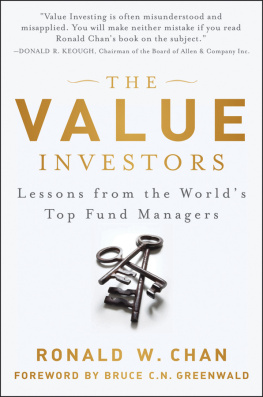| A Few Lessons for Investors and Managers From Warren Buffett |
| Peter Bevelin & Warren Buffett |
| PCA Publishing, Riddler (Jan 2012) |
|
| Rating: |
| Tags: | Wisdom, Financial, Investing, Managerial, Lessons |
| Wisdomttt Financialttt Investingttt Managerialttt Lessonsttt |
Peter Bevelin begins A Few Lessons for Investors and Managers with Warren Buffetts wisdom, "I am a better investor because I am a businessman and a better businessman because I am an investor."
This book is about how managers and investors can increase their chance of success and reduce the chance of harm if managers think more like investors and investors more like businessmen. There are a lot of books about Warren Buffett, but A Few Lessons for Investors and Managers is different. It tells in a short-easy-to-read way about what managers and investors can learn from Buffett.
This is a selection of useful and timeless wisdom where Warren Buffett in his own words tells us how to think about business valuation, what is a good and bad business, acquisitions and their traps, yardsticks, compensation issues, how to reduce risk, corporate governance, the importance of trust and the right culture, learning from mistakes, and more.
About the Author
Peter Bevelin is one of smartest people around.
Hes spent the better part of his life collecting and distilling timeless principles about how we can improve our thinking.
Title Page
A
FEW LESSONS
for
INVESTORS AND MANAGERS
from Warren E. Buffett
Peter Bevelin

This book is
compiled and gifted to book-lovers by
The Rddler
Contents
Epigraph
"I am a better investor because
I am a businessman
and a better businessman
because I am an investor."
-Warren E. Buffett
Introduction and Acknowledgments
Now it is a funny thing about life; if you refuse to accept anything but the best you very often get it.
W. Somerset Maugham
Some managers asked me, "You always talk about the wisdom of Warren Buffettcouldn't you put together a memorandum with some of his key quotes that are useful for us managers?"
There are a lot of books out there about Warren Buffett but I wanted to do it in a shorter-easy-to-read way.
So I selected and arranged his words from the annual reports and The Owner's Manual and added some headlines of my own.
All quotes are from Warren Buffett's Letters to Berkshire Hathaway Shareholders (the year of publication is in parentheses), Copyright 1971-2010 by Warren E. Buffett. Reprinted by permission of Warren E. Buffett; all rights reserved, An Owner's Manual (explains Berkshire's broad economic principles of operation) or Berkshire Hathaway Code of Business Conduct and Ethics. The bold headlines and bold text are my own words.
Thanks to Warren Buffett for his kind permission to quote extensively from his work and for his compliments of my memorandumthe foundation for this book. Thank youyou have really enriched my life. Your yearly letter and doses of timeless wisdom always bring sunshine to my day. You represent the very best of wisdom and human qualities.
I am deeply grateful to Peter Kaufman for his generosity in helping me making the memorandum into a book. Peter doesn't need any lessons he is one of the best businessmen and human beings I know. I am delighted to partner with him. Many thanks also to Marcus Kaufman.
Finally, I wish to thank my beloved and amazing wife, Monica, who drew the picture on the cover page (Warren Buffett's comment was "This looks goodas close as I'll ever look to George Clooney").
Monica, I believe that the best is yet to come.
Peter Bevelin
October 2011
One
What Investing in Financial Assets
is All About
Laying out cash today in order to get more cash back in the future
What return I will get on my cash depends on the price I pay, how much cash I get back, and when I get it back
Long ago, Ben Graham taught me that "Price is what you pay; value is what you get." (2008)
This return can then be compared with the expected return from other available opportunities
Since my return depends on the price I pay compared to what it's worth, I should never pay more than what I get back in value
What is "investing" if it is not the act of seeking value at least sufficient to justify the amount paid? (1992)
To do that I need to be able to figure out what a financial asset is worth-how else can I know what kind of return I can expect at a given price?
We will look at any category of investment, so long as we understand the business we're buying into and believe that price and value may differ significantly. (1990)
Two
Valuation
Follow the cash it's the only thing I can spend
In The Theory of Investment Value , written over 50 years ago, John Burr Williams set forth the equation for value, which we condense here: The value of any stock, bond or business today is determined by the cash inflows and outflows discounted at an appropriate interest rate that can be expected to occur during the remaining life of the asset. (1992)
So valued, all financial assets become economic equals
It applies to outlays for farms, oil royalties, bonds, stocks, lottery tickets, and manufacturing plants. And neither the advent of the steam engine, the harnessing of electricity nor the creation of the automobile changed the formula one iota nor will the Internet. Just insert the correct numbers, and you can rank the attractiveness of all possible uses of capital throughout the universe. (2000)
It doesn't matter where the cash comes from it all spends the same
Dollars are dollars whether they are derived from the operation of media properties or of steel mills. (1991)
The financial asset that has the highest value compared to its price is the one that gives me the highest return
The investment shown by the discounted-flows-of-cash calculation to be the cheapest is the one that the investor should purchase. (1992)
Since the future is unknown, value is naturally a rough estimate, not a precise figure
The calculation of intrinsic value, though, is not so simple. As our definition suggests, intrinsic value is an estimate rather than a precise figure, and it is additionally an estimate that must be changed if interest rates move or forecasts of future cash flows are revised. (An Owner's Manual)
And fancy computers don't help
We believe the precision they project is a chimera. In fact, such models can lull decision-makers into a false sense of security and thereby increase their chances of making a really huge mistake. (1996)
A rough approximation is enough
Our inability to pinpoint a number doesn't bother us: We would rather be approximately right than precisely wrong. (2010)
Using precise numbers is, in fact, foolish; working with a range of possibilities is the better approach. (2000)
Despite its fuzziness, however, intrinsic value is all-important and is the only logical way to evaluate the relative attractiveness of investments and businesses. (1994)
Three
The Value of a Business
A business is similar to a bond but there are some important differences
Note that the formula is the same for stocks as for bonds. Even so, there is an important, and difficult to deal with, difference between the two: A bond has a coupon and maturity date that define future cash flows; but in the case of equities, the investment analyst must himself estimate the future "coupons." (1992)

